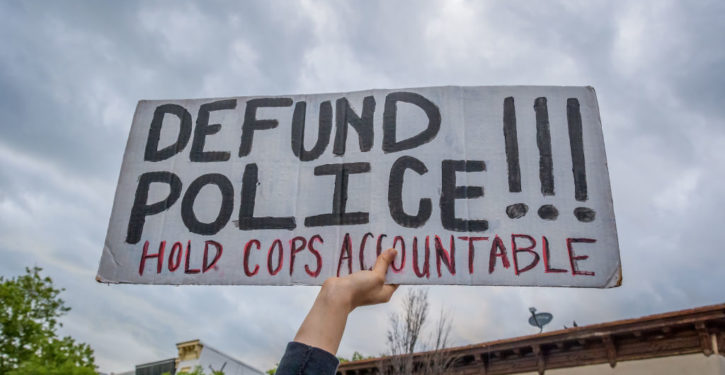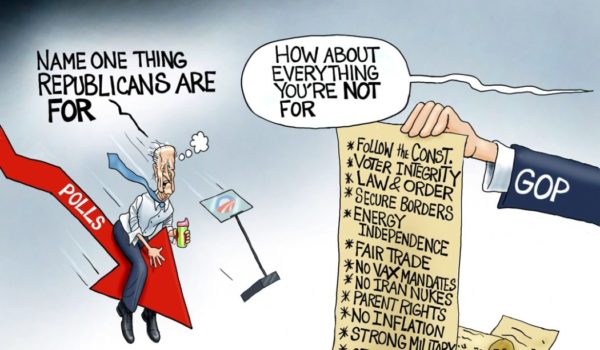
Supporters of abolishing the police say they can be replaced by unarmed “community safety” workers. Instead of arresting or incarcerating criminals, these workers are supposed to promote dialogue and “restorative justice” instead. But such workers cannot keep crime under control. Or even protect themselves.
As Jazz Shaw notes at Hot Air,
During the course of the madness that promoted “defunding” or abolishing the police, there was an emphasis placed on replacing police in some circumstances with “community safety” workers who would supposedly act as unarmed “violence interrupters” and reduce the number of lethal use of force incidents by police officers. In Baltimore, Maryland’s violent gang territories, an existing organization known as the “Safe Streets Program” gained a lot of attention and municipal support in this effort. The goal of the program is to deploy former gang members (or “former”) into areas controlled by the gangs to negotiate nonviolent resolutions to conflicts. Unfortunately, as we’ve seen with other proposed “violence interruption” programs in major cities, sending someone with a clipboard out to resolve a beef between gang members isn’t always effective. That was sadly this case this week when one of Baltimore’s Safe Streets workers was shot to death along with several other people on the East side of Charm City.
A quadruple shooting in East Baltimore on Wednesday night left three people dead, including a Safe Streets worker, and one person injured, police said. Three others were injured in separate shootings in West and South Baltimore.
At about 7:25 p.m., Eastern District patrol officers responded to a ShotSpotter alert in the 2400 block of E. Monument St. Once there, officers located four men suffering from apparent gunshot wounds.
A 28-year-old man was pronounced dead on the scene. Medics transported three other victims to area hospitals, where a 24-year-old man and another man were also pronounced dead.
Some progressive politicians and journalists have demonized the police over the past several years, fueling the push to defund the police.
This demonization has resulted in some progressives mistakenly believing that the police hunt black people. While on duty, America’s police shot and killed 19 unarmed whites and only 9 unarmed blacks in 2019, even though America has over 330 million people. A study by a black Harvard economist found racism is not a big factor in police shootings. So black people are not being hunted by police. By contrast, about three thousand black people are murdered by other black people each year. Between 2010 and 2013, “92 percent of blacks who were murdered were killed by other blacks,” according to PolitiFact. According to FBI data, 89 percent of blacks who were murdered in 2018 were killed by black offenders.
Yet progressives often mistakenly think blacks are killed mostly by the police. In a national survey, “over half (53.5%) of those reporting ‘very liberal’ political views estimated that 1,000 or more unarmed Black men were killed” by police. These progressives were wrong by a factor of 100 or more. A lawyer at a think-tank encountered this fallacy when she wrote about a police shooting that was ruled justified by prosecutors. A progressive “responded angrily,” erroneously claiming that “millions of black people” are “being hunted down and murdered by the police.”
Higher police spending is correlated with lower murder rates, showing that defunding the police costs lives.
Some advocates of defunding the police complain that the police “overpolice” black people, resulting in blacks being arrested at a higher rate than white people despite supposedly having the same crime rate. Studies debunk this claim.
Racial differences in crime rates are real. The federal Bureau of Justice Statistics has noted that when it comes to homicide, “the offending rates for blacks were more than 7 times higher the rates for whites” between 1976 and 2005. (See BJS, Homicide Trends in the United States).
Nor are blacks “overpoliced” versus whites. For example, blacks are not more likely to be arrested when they commit a violent crime than a similarly-situated white person is. A 2021 study by the federal Bureau of Justice Statistics found that although blacks are arrested for serious nonfatal violent crimes at more than twice the rate of people in general, this is not due to racism. Instead, arrests are correctly “proportional” to the actual crime rate (which is higher among blacks than among whites), and to the crimes actually reported to the police, which often are committed by black offenders. As it noted, in 2018, “white and black people were arrested proportionate to their involvement in serious nonfatal violent crime overall and proportionate to their involvement in serious nonfatal violent crime reported to police.” (See Allen J. Beck, Race and Ethnicity of Violent Crime Offenders and Arrestees, 2018).
After George Floyd’s death and the riots that followed, some police pulled back from proactive policing. That emboldened criminals, and contributed to a big increase in murders that harmed blacks most. America’s murder rate rose a record 30% between 2019 and 2020 – the largest single-year increase on record, notes U.S. News. In major American cites, over 85 percent of the increase in murders occurred in black and Hispanic neighborhoods, where homicide rates were already higher than in white neighborhoods.
Some progressives have sought to blame the coronavirus pandemic for the spike in murders in 2020. But the coronavirus epidemic affected the whole world and shut down schools and community institutions in many countries. Yet the United States was almost alone in having a huge increase in homicides in 2020. Most of the world saw reductions in homicide rates in 2020.
Murder rates actually fell in most countries that lost many people to the coronavirus. Peru had the world’s highest coronavirus death rate per million inhabitants, between double and triple America’s death rate. Yet Peru’s homicide rate fell by more than 2% in 2020. Three times as high a percentage of Peruvians died of the virus compared to Americans. Many Peruvians lost their jobs, many services shut down, and Peru’s economy shrank by 12%, unlike America’s economy, which shrank by only 3.5%. Yet Peru’s murder rate fell.
Mexico’s homicide rate fell in 2020, even though Mexico and the United States lost similar fractions of their citizens to the coronavirus, and even though Mexico’s economy crashed much worse than the United States’s during the pandemic. Murder rates also fell in other countries hit hard by the epidemic, like France and Italy.
A Washington Post op-ed writer mistakenly sought to pin the rise in homicides on the pandemic and lockdowns that reduced the number of witnesses to potential crimes on the street. But that was wrong — countries that suffered just as much from the pandemic, and had harsher lockdowns, had declining murder rates in 2020. For example, France had a much harsher lockdown regime than the United States, with even walking alone outside the house being strictly restricted. Yet its murder rate fell in 2020, even as its economy shrank more than America’s during the pandemic (8.3% versus 3.5%), and French people experienced widespread despair during the pandemic (although the coronavirus death rate was somewhat lower in France than notoriously obese America. Obesity makes people more vulnerable to COVID-19 and increases their death and hospitalization rates. Most people hospitalized for the coronavirus were obese.).



